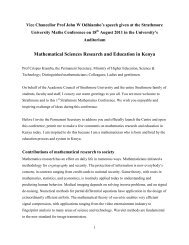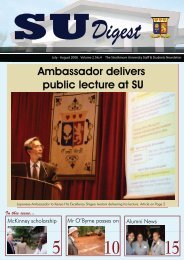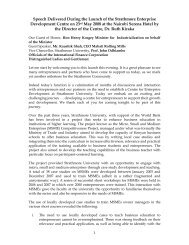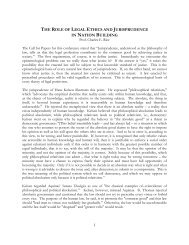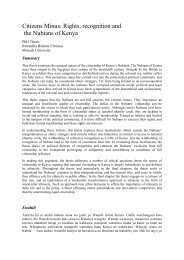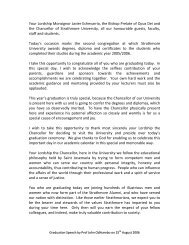Lucy-Gikonyo-paper Nataka-Chakula.pdf - Strathmore University
Lucy-Gikonyo-paper Nataka-Chakula.pdf - Strathmore University
Lucy-Gikonyo-paper Nataka-Chakula.pdf - Strathmore University
- No tags were found...
Create successful ePaper yourself
Turn your PDF publications into a flip-book with our unique Google optimized e-Paper software.
“<strong>Nataka</strong> chakula” (I’d like food): Critical Success Factors in Attracting and Retaining<br />
Customers in Kenyan Restaurants<br />
<strong>Lucy</strong> <strong>Gikonyo</strong><br />
<strong>Strathmore</strong> <strong>University</strong>, Nairobi, Kenya, and<br />
Adele Berndt<br />
Jonkoping International Business School, Sweden<br />
Abstract<br />
Purpose–This <strong>paper</strong> explores the critical success factors in attracting and retaining<br />
customers in Kenyan restaurants.<br />
Design/methodology – This was an exploratory study using a qualitative approach,<br />
specifically focus group discussions. The participants were identified using convenience<br />
sampling. Five focus group discussions were carried out in Nairobi, Kenya. The data<br />
were transcribed and analyzed using content analysis.<br />
Findings – It is suggested that there was an increasing trend of eating out in Kenya and<br />
this trend was mostly triggered by the desire to save on time and effort used to cook, to<br />
socialize with friends and as an opportunity to engage business associates. Further, a<br />
customer’s decision to eat at a certain restaurant for the first time was influenced by peer<br />
pressure, reputation of the eating place, and the state of mind. This would suggest the use<br />
of brand ambassadors in attracting customers to new outlets. The results suggested the<br />
decision to patronize a restaurant was heavily influenced by a great offer in terms of<br />
product and service, customer care and consistency. Specifically, customers care a lot<br />
about product quality, value for money in relation to price, quality of service,<br />
atmosphere/ambience, customer care and consistency when choosing which restaurants to<br />
patronize. In addition, the study noted that lack of consistency can influence the decision to<br />
defect from a restaurant. Specifically, lack of consistency in food quality, food quantity,<br />
food prices, service and environment may lead to defection.<br />
Originality/value – This <strong>paper</strong> has added value in theory building as it has validated the<br />
basis on to which a survey can be conducted in order to prioritize the identified critical<br />
success factors. The results have also reduced the heat to light ratio to the inconclusive<br />
discussion of critical success factors.<br />
Keywords Critical success factors, restaurant industry, customers, Kenya<br />
1
Introduction<br />
The restaurant industry has developed and expanded to gain a global presence in the last<br />
fifty years largely fuelled by the change of lifestyles. Urban populations have grown<br />
throughout the world, mobility of people has increased and people spend a lot of time<br />
commuting to and from work (Schlosser, 2001). This has been compounded by the<br />
increased presence of women in the workplace which has resulted in less time available for<br />
them to prepare meals at home (Jekanowski, Binkley & Eales, 2001). These busier<br />
consumer lifestyles and dual-working families have led to solutions being sought in using<br />
readymade meals (Atkins and Bowler, 2001). For a long time, growth and expansion in the<br />
restaurant industry has been associated particularly with the fast food concept (Lashley &<br />
Morrison, 2004; Sen 1998).<br />
Viewed from the customers’ perspective, Anderson and Fornell (2000) assume that<br />
businesses exist and compete to satisfy the customers. They suggest that it is not possible<br />
to grow a business without at the same time increasing customer satisfaction. A satisfied<br />
customer will become a repeat customer and this could in turn grow a business. Following<br />
this general business imperative therefore it means that a satisfied customer will have a<br />
critical effect on the long-term success of restaurant business. A satisfied restaurant<br />
customer will remain loyal to an outlet or restaurant business and continued patronage can<br />
follow a global pattern. On the other hand a dissatisfied customer of restaurant will not<br />
only avoid the entire franchise or chain outlets but may also make bad publicity and<br />
persuade many people to go elsewhere (Gilbert et al, 2004). This presents an eating<br />
establishment (such as a restaurant) with a challenge. They need to satisfy customers to<br />
gain repeat business, but what do they need to do Where should a restaurant focus their<br />
energies and attention if they are to not only attract new customers but also to keep existing<br />
customers satisfied The focus of attention is on what are regarded as the Critical Success<br />
Factors (CSFs), but there is little published research on CSFs in the restaurant industry in<br />
Africa, a gap this study aims to fill.<br />
2
The <strong>paper</strong> will investigate the nature of CSFs specifically in the restaurant (food) sector and<br />
then discuss the study that has been carried out. The <strong>paper</strong> will conclude with the<br />
discussion and implications of the research for the Kenyan restaurant market.<br />
Research Question and research objectives<br />
It has been suggested that an increase in customer retention of 5% can result in an increase<br />
in profits of more than 20% (Reichheld & Sasser, 1990). This figure has encouraged<br />
organizations not just to focus on customer attraction, but also customer retention in their<br />
operations. But this raises the question of what it is that restaurants need to do to both attract<br />
and retain patrons (customers). The primary objective of the research was to investigate<br />
customer perceptions of restaurants, focusing on how these restaurants can attract new and<br />
retain existing customers. The <strong>paper</strong> investigates issues relating to attracting customers to a<br />
new restaurant, how to retain the customer and potentially what may result in the defection<br />
of the customer from the restaurant.<br />
Literature Review: Eating out Trends<br />
Target Group Index (TGI) (2005) analyzed consumption habits and attitudes towards fast<br />
food in 15 countries to uncover the latest international trends and variations and discovered<br />
that in 12 out of the 15 markets analyzed, the majority of people eat fast food. Australia and<br />
the US are home to the largest proportion of fast food consumers with almost nine out of<br />
every ten people in each market choosing to eat it. In both countries, fast food consumption<br />
is particularly high among young men (aged 18-24). The nations with the lowest prevalence<br />
of fast food consumers can be found in Europe and Latin America. In Spain and Brazil less<br />
than half of people claim to eat fast food, and in Hungary the figure drops to just 35%.<br />
Almost half (46%) of Hungarians think that 'fast food is all junk', a belief which appears to<br />
be fairly consistent across age groups.<br />
Gowdin (2008) asserts that where once a “meal out” was a special occasion, for many<br />
people it is now regarded as a regular treat. According to one recent survey, 70 per cent<br />
of people now claim to eat out at least once a month (Mintel, 2007). Snacking<br />
throughout the day is also a growing trend; out of home snacking occasions were<br />
3
expected to grow by 10 per cent by 2010 (Data Monitor, 2006). Stuppy (2009) noted<br />
that top reasons today's consumers choose foods are because of taste, price,<br />
healthfulness, and convenience in that order. Therefore, food manufacturers and<br />
restaurants will need to be attentive to these as they compete for consumer dollars.<br />
Katago (2009) asserts that the “eating out” culture is yet to pick in Kenya, despite a<br />
rapid expansion in urban centers and a growing middle class. This is contrary to the<br />
trend in the developed world where individuals and families take meals in restaurants,<br />
and they even make an occasion out of it.<br />
Mutisya, Sagwe and Kazungu (2010) sought to explore the emerging casual dining<br />
trends in the restaurant industry in Kenya. The findings of the study show that dining<br />
out is taking a more casual approach, and that having a food selection that reflects the<br />
ethnicity of the target market is an important aspect.<br />
Critical Success Factors Theory<br />
The identification of “success factors” was first proposed by Daniel, (1961) in an article<br />
on Management Information Crisis. It was later refined by Rockart (1979:85) who uses<br />
the term ‘Critical Success Factors’ to mean: “The limited number of areas in which<br />
results, if they are satisfactory, will ensure successful competitive performance in an<br />
organization”. In this definition Rockart (1979) emphasizes that these areas of activity<br />
are key and must “go right”, therefore they should be carefully managed by the company<br />
to ensure success. Other definitions exist, Leidecker and Bruno (1984:24) saw CSFs as<br />
“those characteristics, conditions or variables that when properly managed, can have a<br />
significant impact on the success of a firm competing in a particular industry”.<br />
Rockart (1979) identifies sources of CSFs as industry based, from environmental<br />
situations, geographical locations, temporal factors or strategic situations. This approach<br />
of CSFs focuses on information needs for purposes of management control and seeks to<br />
identify data which can be used to monitor and improve existing areas of business<br />
(Amberg, et al, 2005). In some research, this emphasis of deriving CSF from<br />
4
management has been criticized as it has been seen as an approach which relies only on<br />
opinions of managers (Davis, 1980). Munro & Wheeler (1980) suggested that middle<br />
managers views should be incorporated while Boynton & Zmud (1984) proposed that a<br />
cross-section of managers’ views should be incorporated as well as opinions of other<br />
stakeholders in the organization. This widespread consultation was seen as<br />
strengthening the CSF approach because it was viewed that success of an organization<br />
does not depend only on managers. This particular <strong>paper</strong> supports Boynton & Zmud<br />
(1984) and argues that customer’s opinions about critical success factors are crucial.<br />
Consequently, customers are an important source of CSFs.<br />
Though CSFs have been widely applied they seem to have a generic essence (Brotherton<br />
& Shaw, 1996). They have a focused specialization in areas which give the company<br />
the greatest competitive advantage, and which therefore become “key” and receive<br />
priority in resources allocation and effort. Brotherton (2004) observed that studies on<br />
CSFs had largely been done in the USA and Asia- pacific region and UK. There is no<br />
evidence of literature on CSFs in restaurant industry in developing nations of Africa and<br />
this study aims to contribute to fill this gap.<br />
Critical success factors Considered by a Customer When Choosing to Patronize a<br />
Restaurant<br />
Literature suggests that there are a number of general CSFs that are important to customers<br />
in the selection of a restaurant. The Most Engaged Customers Report (2010) attempted to<br />
measure the customer loyalty of 26 selected brands. First, the study found out that those<br />
companies excelling at retaining customers were financially out-performing their industry<br />
peers. Furthermore, the report discovered those customers who chose a company based on<br />
recommendation were more engaged and forgiving in case of unintended disappointment in<br />
service quality. Most Engaged Customers Report (2010) argued that their research across<br />
all consumer industries had revealed a hierarchy of needs that together create customer<br />
loyalty. Customer loyalty requires all elements to be present. Specifically, these are: The<br />
offer made up of products, services and/or experiences that customers want or need; Care,<br />
that is a company culture that cares for and values customers; Consistency, meaning<br />
5
excellent service at every touch point; Trust meaning if something goes wrong, the<br />
customer has faith the company will put it right; Effort meaning that employees should<br />
exert extra effort and go above and beyond customer expectations.<br />
In the case of restaurant patronage, a recent survey has indicated the importance of wordof-mouth<br />
in the selection of a restaurant. The survey indicated that 48.9% of respondents<br />
used recommendations from friends to select a restaurant while 79.8% of respondents<br />
indicated that they influenced others in their selection of restaurants (Oliver & Owens,<br />
2012).<br />
Mutisya, Sagwe and Kazungu (2010) noted in their study, that 52% of the respondents<br />
interviewed indicated that they patronize certain establishments due to the quality of<br />
services offered, 21% related to convenience of the location, 10% are attracted by the high<br />
standards set through pricing which drives away idlers, 3% due to availability of ample and<br />
secure parking space, 3% due the uniqueness of the dining concept and 10% because of a<br />
combination of ambience and good location. Respondents were also asked to rate patronage<br />
on the basis of perceived income levels of the patrons. Their responses indicate that 59% of<br />
the establishments are frequented by upper middle income earners, 19% by what they<br />
considered to be affluent, 11% by low income earners and 11% by a mix of affluent, upper<br />
middle income earners.<br />
Melia (2012) conducted a study on Critical Success Factors and Performance Management<br />
and Measurement in the context of the Hospitality sector in Ireland. The study noted that<br />
critical success factors such as quality of product, employees, quality of service, customer<br />
satisfaction, location and the quality of the infrastructure can be measured and<br />
benchmarked against the competitor in order to provide a sustainable competitive<br />
advantage and therefore should be part of the performance measurement process. One can<br />
isolate several aspects from Melia (2012) that relate to the factors that customers consider<br />
when deciding to patronize a hotel namely; quality of product, employees, quality of<br />
service, customer satisfaction, location and the quality of the infrastructure. Conversely, if<br />
these factors are regarded as important for a restaurant, absence of these factors will result<br />
6
in a customer not returning. Zikiene and Bakanauskas (2008) conducted a study on factors<br />
influencing loyal customers switching behavior in Lithuania. The study took a sample of<br />
150 customers from one company. The authors concluded that the most important factor<br />
that caused switching behavior was dissatisfactory quality (mean score of 4.56 out of 5),<br />
followed by poor response to service failures (4.17), looking for new value (3.74), core<br />
service failures (3.41); service encounter failures (3.40), and inconsistent pricing and price<br />
issues (3.36).The findings are relevant to this study as they identify consistency in quality,<br />
service and prices.<br />
In the case of fast food restaurants, convenience has also been identified as being a CSF.<br />
Convenience in the case of food is associated with the removal of the need to prepare the<br />
food (Jekanowski et al., 2001). In the case of the fast food restaurants, convenience is not<br />
only the ability to get food that has already been prepared but also that the distance that has<br />
to be travelled is relatively short (as consumers will not travel long distances) (Jekanowski<br />
et al., 2001). This implies that the product (food) is easy to access.<br />
Research Methodology<br />
Use was made of a qualitative approach in the research due to the exploratory nature of the<br />
research. As indicated earlier, the “eating out phenomenon” is a not a developed one in<br />
Kenya, and thus a qualitative approach was used. Five focus groups were used as this<br />
method provides interaction with a larger number of people, all of whom can provide<br />
insights into the research topic. Use was made of a questioning guide as the basis for the<br />
discussion.<br />
Convenience sampling was used to get participants in the focus group. The respondents<br />
were drawn from <strong>Strathmore</strong> <strong>University</strong>. A screening questionnaire was sent to potential<br />
respondents (before taking part). Respondents who indicated that they ate out were invited<br />
to participate in the study.<br />
All the sessions were recorded and then transcribed. Content analysis was used to make<br />
meaning out of the group responses. Content analysis is extremely well-suited to analyzing<br />
7
data on the multifaceted, sensitive phenomena characteristic of nursing and customer<br />
perceptions. Specifically, after making sense of the data, analysis was conducted using an<br />
inductive approach (Kyngas & Vanhanen, 1999). The use of inductive content analysis is<br />
recommended when there are no previous studies dealing with the phenomenon or when<br />
knowledge is fragmented. The inductive approach/process included open coding, creating<br />
categories and abstraction. Open coding was applied when notes and headings were written<br />
in the text while reading it. In addition, the written material was read through again, and as<br />
many headings as necessary were written down in the margins to describe all aspects of the<br />
content (Hsieh & Shannon 2005). The headings were then collected from the margins into<br />
coding sheets and categories were freely generated from these coding sheets. After this<br />
open coding, the lists of categories were grouped under higher order headings (Burnard,<br />
1991).The aim of grouping data was to reduce the number of categories by collapsing those<br />
that are similar or dissimilar into broader higher order categories. The purpose of creating<br />
categories was to provide a means of describing the phenomenon, to increase understanding<br />
and to generate knowledge. When formulating categories by inductive content analysis, the<br />
researcher comes to a decision, through interpretation, as to which things to put in the same<br />
category (Elos and Kyngas, 2008).<br />
Results<br />
The Trend of “Eating out” in Kenya<br />
The concept of “eating out” and reasons for its popularity were used at the start of the focus<br />
group discussion. The respondents were requested to indicate their opinions on “eating<br />
out”, whether they have observed such a trend and what could have contributed to the trend<br />
if any. Findings indicate that the “eating out” trend was emerging in Kenya. Though not<br />
well developed, respondents were positive about the existence of such a trend. The<br />
response that best demonstrated this finding was:<br />
“I think a lot of Kenyans nowadays are adapting to eating out. Maybe because of<br />
the way we are trying to get into the whole 24 hour business economy thing, but it is<br />
not yet there. But people are really trying. But nowadays since there are more<br />
women working; women tend to buy even their families dinner out. They take, take -<br />
out for their families and stuff like that. So I think its growing”.<br />
8
All the focus group discussions (FGD) brought out one of the components of eating out as<br />
convenience that is occasioned by lack of time, saving of effort needed to cook, lack of<br />
cooking skills along with speed of service delivery in the various restaurants, as an<br />
important factor in choosing where to dine out. The response that best demonstrated this<br />
finding was:<br />
“We are in a society now that is , we are ever busy, we are ever working, we don’t<br />
have time to cook for ourselves anymore so what do I do The only option is to go<br />
and get something from the nearest food outlet that I can get”.<br />
This <strong>paper</strong> therefore suggests that convenience is an important characteristic and is a<br />
motivating factor for the trend towards “eating out”. The quick service restaurants therefore<br />
may offer convenience in order to gain competitive advantage in the food service industry.<br />
Customers are able to select their products from a hanging menu and often receive their<br />
order as soon as they have made their payment at the point of sale.<br />
Another reason for the emerging trending in “eating out” was the desire to socialize. All<br />
members of the family, for instance, working adults, the youth and the children look<br />
forward to eating out during the weekend (mostly on Sunday) in order to break the routine<br />
of the week’s activities and also get to socialize with their friends. The response that best<br />
illustrated this finding was:<br />
“…. So for socializing, catching up with what has been going on the whole week<br />
and also to bring the monotony of the daily business…..”<br />
This study therefore notes that the need to socialize is an important element that can be<br />
used to explain the emerging trend of “eating out” in Kenya.<br />
After identifying whether a trend of “eating out” existed in Kenya, and the reasons for the<br />
existence of such a trend, the study thought it logical to establish the factors that customers<br />
consider when visiting a restaurant for the first time. The respondents of this study were<br />
therefore requested to indicate the factors they considered when visiting a restaurant for the<br />
first time.<br />
9
In another instance, respondents indicate that peer pressure and recommendations from<br />
friends were important factors that motivated them to visit a certain restaurant for the first<br />
time. The response that best illustrated this finding was;<br />
“From what have seen around mostly it is because was out of influence, someone<br />
goes out and finds this restaurant providing some excellent services…I mean she<br />
comes in and shares out with friends….”.<br />
This study notes that peer pressure and recommendation from friends is therefore a crucial<br />
factor in attracting customers to a restaurant. The restaurant management should therefore<br />
take into consideration the need to create brand equity through brand ambassadors who<br />
may be celebrities or the regular customers. This is because recommendations and referrals<br />
are the strongest and cost effective ways of attracting customers to a restaurant for the first<br />
time.<br />
Findings indicated that the component of price was a crucial factor that customers took into<br />
consideration when deciding whether or not to visit a particular restaurant for the first time.<br />
The people said they would visit a restaurant if the price was pocket friendly and if the<br />
restaurant offered value for their money. The responses that best illustrated this finding<br />
were;<br />
“First of all I have to have the money, and when I have the money it will determine<br />
where I am going to go”.<br />
The <strong>paper</strong> also sought to establish the factors considered by a customer when choosing to<br />
continue visiting a restaurant. The respondents were therefore requested to express their<br />
opinions on what factors they considered when choosing to continue visiting a restaurant.<br />
Findings indicated that customer considered a great offer in terms of product and service<br />
when deciding to patronize a restaurant. A great offer is made up of products, services<br />
and/or experiences that customers want or need. Specifically, a good offer is characterized<br />
10
y product quality, value for money (quantity and quality in relation to price), quality<br />
service, efficient service, good ambience, relaxing and hygienic environment.<br />
In reference to a great offer, product quality was also widely indicated by participants.<br />
Customers may therefore decide to continue visiting a restaurant if the food was of good<br />
quality and tasted good. The response that best illustrated this response was:<br />
“First and foremost I look at the quality. I want to eat food that I am assured what<br />
am eating is okay, the content is of quality”.<br />
The FGD mentioned the component of service a great deal. They like to go to restaurants<br />
where service is efficient, and wait staff are attentive to customers without any<br />
discrimination. The speed of service is important to them, they do not like to feel forgotten<br />
or ignored. People also like to see neat and clean wait staff that is well groomed and have<br />
good personal hygiene habits.<br />
The FGD mentioned a ‘cool atmosphere’ nice relaxing music as indications of<br />
atmosphere/ambience in the restaurants. People will keep going to a restaurant that<br />
captures their taste in ambience. The FGD also mentioned aspects of space as being<br />
important, they do not like to go to restaurants that are squeezed but rather to those that<br />
have adequate spacing between tables. The response that best illustrated this finding was:<br />
“Somewhere you can just relax, I want that to be able to freely eat and in peace”.<br />
To verify the factors that attracted customers to a restaurant, FGD were also asked about<br />
factors that would make them not return to a specific restaurant. It was determined that a<br />
lack of consistency in the various elements that attracted the customer to the restaurant and<br />
made the customer to visit the restaurant again can influence the decision to defect from a<br />
restaurant. Specifically, lack of consistency in food quality, food quantity, food prices,<br />
service and environment may lead to defection.<br />
Inconsistency in food quality was one of the frequently cited factors that may influence<br />
customer defection. The responses that best explained this finding were:<br />
11
“Bad food .There’s nothing as bad as you pay for something and then you can taste<br />
that food is not fresh at all…. basically those are the two most annoying things that<br />
make me never go back to a restaurant”.<br />
Inconsistency in service is another factor that may influence customer defection.<br />
Inconsistency in price is another factor that may influence customer defection. Customers<br />
would stop visiting a restaurant if the prices changed abruptly or if the products became<br />
unaffordable.<br />
Inconsistency in ambience, environment and space is another factor that may influence<br />
customer defection. The response that best suited this finding was:<br />
“I like space, if have paid for something, like I have’ paid to let’s say to,<br />
considering the price of course they offer, I have paid for service to sit here and<br />
then I end up like my, being knocked all over, as in, spilled my food then definitely, I<br />
will not go back there”.<br />
Discussion<br />
Results from this study suggest that “eating out” is perceived as an emerging trend in<br />
Kenya. The main reason for the emergence of the trend was convenience. The patrons of<br />
restaurants seem to be busy due to tight working schedules and “eating out” becomes an<br />
effective and convenient solution. Other reasons for the emergence of the trend are the<br />
desire to socialize. The typical urban Kenyan family may view “eating out” as an activity or<br />
lifestyle that is justified by the monotonous activities of the week.<br />
Respondents indicate that peer pressure and recommendations from friends were important<br />
factors that motivated them to visit a certain restaurant for the first time. Peer pressure and<br />
recommendation from friends is therefore a crucial factor in attracting customers to a<br />
restaurant. Findings indicated that the component of price was a crucial factor that<br />
customers took into consideration when deciding whether or not to visit a particular<br />
restaurant for the first time. The people said they would visit a restaurant if the price was<br />
pocket friendly and if the restaurant offered value for their money.<br />
12
Findings indicated that customer considered a great offer in terms of product and service<br />
when deciding to patronize a restaurant. A great offer is made up of products, services<br />
and/or experiences that customers want or need. Specifically, a good offer is characterized<br />
by product quality, value for money (quantity and quality in relation to price), quality<br />
service, efficient service, good ambience, relaxing and hygienic environment. In reference<br />
to a great offer, product quality seems to have been the most widely cited. Customers may<br />
therefore decide to continue visiting a restaurant if the food was of good quality and tasted<br />
good. Results implied that the component of service matters a great deal, they like to go to<br />
restaurants where service is efficient, and wait staff are attentive to customers without any<br />
discrimination. The speed of service is important to them, they do not like to feel forgotten<br />
or ignored. People also like to see neat and clean wait staff that is well groomed and have<br />
good personal hygiene habits. Results also indicated that a ‘cool atmosphere’ nice relaxing<br />
music as indications of atmosphere/ambience in the restaurants. People will keep going to a<br />
restaurant that captures their taste in ambience. Findings indicated that customer considered<br />
customer care when deciding to continue frequenting a restaurant. Customer Care is a<br />
company culture that cares for and values customers. People will go to restaurants where<br />
they feel welcome, where the wait staff is friendly, courteous and respectful. They will<br />
frequent restaurants where they are recognized and treated as family.<br />
The study established that lack of consistency in the various elements that attracted the<br />
customer to the restaurant and made the customer to visit the restaurant again can influence<br />
the decision to defect from a restaurant. Specifically, lack of consistency in food quality,<br />
food quantity, food prices, service and environment may lead to defection.<br />
There are a number of managerial implications from this research. The management of<br />
restaurants needs to take into consideration the growing trend of “eating out” and the<br />
reasons for its growth. In line with this observation, the management needs to develop<br />
products and service offerings that serve the convenience concerns of the restaurant<br />
customers.<br />
The findings show that peer pressure and recommendation from friends is a crucial factor in<br />
attracting customers to a restaurant. The restaurant management should therefore take into<br />
13
consideration the need to create brand equity through brand ambassadors who may be<br />
celebrities or the regular customers. This is because recommendations and referrals are the<br />
strongest and cost effective ways of attracting customers to a restaurant for the first time.<br />
Furthermore, those customers who chose a company based on recommendation are likely to<br />
be more loyal and forgiving in case of unintended disappointment in service quality. Hence,<br />
increasing positive word-of-mouth and referrals should be a goal for any organization.<br />
The study noted that a great offer in term of quality service and product, customer care and<br />
consistency are important factors for restaurant patronage. Therefore, management should<br />
ensure that these critical areas are monitored and taken care of at all times. In addition,<br />
management attention and the resources should be directed towards these critical success<br />
factors.<br />
Of particular concern and importance is the concept of consistency. Lack of consistency in<br />
food quality, food quantity, food prices, service and environment may lead to defection of<br />
customers. Management effort should therefore be focused on ensuring that the critical<br />
success factors are managed consistently.<br />
The limitations are a reflected in the research methodology used. A convenience sample<br />
may not be as robust and representative as a different type of sample. In addition, content<br />
analysis is usually regarded as being subjective as it involves individual bias in the<br />
selection of themes, headings, categories and abstractions. Furthermore, critical success<br />
factor methodology is also prone to limitations especially in terms of ambiguousness and<br />
the need to contextualize it in order to derive practical relevance. However, the study also<br />
acknowledges that these are limitations of qualitative methodologies that do not negate the<br />
importance and effectiveness of these methodologies in making sense out of real life<br />
problems. A further limitation is the depth of studies investigating CSF in the hospitality<br />
and restaurant sectors in African countries, and specifically in Kenya. Further research<br />
would be recommended especially of a quantitative nature.<br />
Conclusion<br />
The primary objective of the research was to investigate customer perceptions of<br />
restaurants, focusing on how these restaurants can attract new and retain existing<br />
14
customers. The <strong>paper</strong> investigates the critical success factors relating to attracting<br />
customers to a new restaurant, how to retain the customer and potentially what may<br />
result in the defection of the customer from the restaurant.<br />
Focus groups conducted indicated that customers consider the peer pressure and opinions<br />
of brand ambassadors such as fellow customers and friends, reputation of the restaurant, the<br />
brand name and image as critical factors in deciding whether to visit a particular restaurant<br />
or not.<br />
Focus groups conducted indicated that the critical success factors that customers consider<br />
when choosing to continue visiting a particular restaurant are great offer in term of quality<br />
service and product, customer care and consistency. Focus groups conducted indicated<br />
that the critical success factors that may result in customer defecting from a restaurant<br />
include lack of consistency in food quality, food quantity; food prices, service and<br />
environment.<br />
References<br />
Amberg, M. Fischl, F. Weiner, M. (2005) “Background of critical success factor research” working<br />
<strong>paper</strong> No. 2/2005 Friedrich-Alexander-Universitat Erlangen-Nurnberg<br />
Anderson, E. W., and Fornell,C. 2000. “Customer Satisfaction, Market Share, and Profitability.”<br />
Journal of Marketing 58 (July): 53-66.<br />
Bitner, M. J. (1990). “Evaluating service encounters: the effects of physical surroundings and<br />
employee responses”, Journal of Marketing, April.<br />
Brotherton, B. and Shaw, J. (1996),“Towards identification and classification of critical success<br />
factors in UK Hotels Plc”, International Journal of Hospitality Mangement, Vol. 15 No. 2,<br />
pp. 103-17.<br />
Brothreton B. (2004),“Critical success factors in UK budget hotel operations”, International<br />
Journal of Operations and Production Management Vol. 24 No. 9 pp. 944-969.<br />
Boynton, A.C. and Zmud, R.W. (1984), An assessment of critical success factors”, Sloan<br />
Management Review (pre 1986), Vol. 25 pp 17.<br />
Burnard P. (1991) A method of analysing interview transcripts in qualitative research. Nurse<br />
Education Today 11, 461–466.<br />
Daniel, D.R. (1961), “Management information crisis”, Harvard Business Review, 39, 111-121.<br />
15
Data monitor (2006). New Trends in Snacking and Drinking on the go.<br />
http://www.nestleprofessional.com<br />
/uk/en/CulinaryExpertise/Culinary_Expertise/Pages/Eating_out_trends_and_the_drivers_of<br />
_growth.aspx<br />
Davis, G.B. (1980). “From our readers”, MIS Quarterly, Vol. 4 pp 69.<br />
Gilbert, G.R., Veloutsou, C., Goode, M.M.H. and Mountinho, L. (2004), “Measuring customer<br />
satisfaction in the fast food industry: a cross national approach”, Journal of Services<br />
Marketing, Vol. 18 No. 5, pp. 371-83.<br />
Hsieh H.-F. & Shannon S. (2005) Three approaches to qualitative content analysis. Qualitative<br />
Health Research 15, 1277–1288.<br />
Katago C. (2009). Why Kenyans will soon be eating out. Retrieved from<br />
http://www.capitalfm.co.ke /business/2009/01/why-kenyans-will-soon-be-eating-out/<br />
Kyngas H. & Vanhanen L. (1999). Content analysis (Finnish). Hoitotiede 11, 3–12.<br />
Lashley, C. and Morrison,A. (Eds) (2000),“Franchising Hospitality Services”, Butterworth-<br />
Heinemann, Oxford.<br />
Leidecker, J. and Bruno, A. (1984), “Identifying and using critical success factors”, Long Range<br />
Planning, 17, 23-32.<br />
Melia D (2011). Critical Success Factors and Performance Management and Measurement: A<br />
Hospitality Context. http://www.shannon college.com/wp-ontent/uploads/2009/12/Critical-<br />
Success-Factors-and-Performance-mgmt-D-Melia.<strong>pdf</strong><br />
Mintel (2007). Eating Out Habits, Leisure Intelligence. Retrieve from http://www. Nestle<br />
professional.com/uk/en/CulinaryExpertise/Culinary_Expertise/Pages/Eating_out_trends_an<br />
d_the_drivers_of_growth.aspx<br />
Most Engaged Customers Report (2010). Overall Sector Consumer Report. Retrieved<br />
fromhttp://www.scribd.com/doc/63805250/B2C-Most-Engaged-Customers-Study-<br />
PeopleMetrics<br />
Munro, M.C. and Wheeler, B.R. (1980),“Planning critical success factors and management’s<br />
information requirements”, MIS QuarterlyVol 4, pp 27-38.<br />
Rockart, J. (1979), “Chief executives define their own information needs”, Harvard Business<br />
Review, March/April pp 81-92.<br />
Rockart, J., and Christine, V.A. (1981),“A primer on critical success factors”, Cambridge, MA:<br />
Center for Information Systems Research, Massachusetts Institute of Technology.<br />
Schlosser, Eric. 2001. Fast Food Nation. New York: Houghton-Mifflin.<br />
Sen, K.C. (1998),“The use of franchising as a growth strategy by US restaurant franchisors”,<br />
Journal of Consumer Marketing, Vol. 15 No. 4 pp 397- 407.<br />
Stuppy P. (2009). Food trends in 2009. Retrieved from http://www.seacoastonline.com /articles/<br />
20090315 -LIFE-903150305<br />
Target Group Index (TGI) (2009). Fast food trends analysed. http://www.bizcommunity.<br />
com/Article/196/87/6281.html<br />
16
Zikiene, K and Bakanauskas A. P (2008). Research of factors influencing loyal customer switching<br />
behavior. http://www.mediastudies.lt/sites/default/files/Bakanauskas%20Zikiene.<strong>pdf</strong><br />
Reichheld, F.F., and Sasser, W.E. 1990. Zero defections: quality comes to services Harvard<br />
Business Review, Sept-Oct, 1990, Vol.68(5), p.105.<br />
Oliver, C.G., and Owens, R. 2012. Groundbreaking survey reveals how diners choose restaurants.<br />
http://www.angelsmith.net/blog/groundbreaking-survey-reveals-how-diners-choose-restaurants/<br />
(accessed 25 September 2012).<br />
Jekanowski, M.D., Binkley, J.K., and Eales, J. 2001. Convenience, Accessibility, and<br />
the Demand for Fast Food, Journal ofAgricultural and Resource Economics 26(1):58-74.<br />
17





